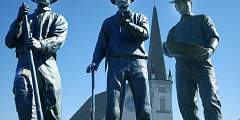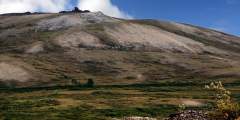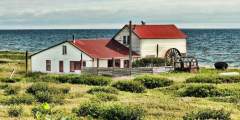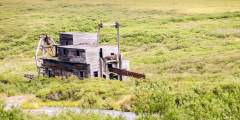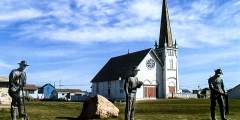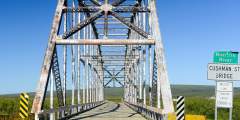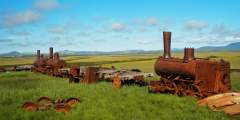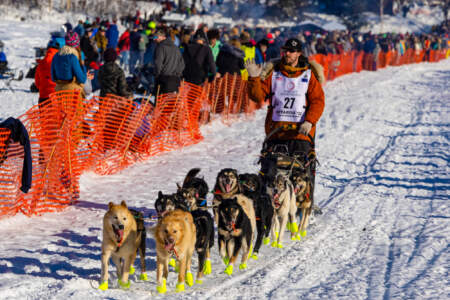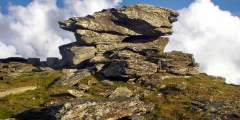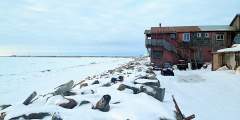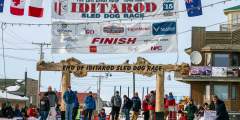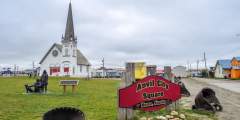Nome Day Tours & Attractions
Show Map
Day Tours & Attractions
Visitor Information Centers View All
Traveling to Nome? Make the Nome Visitors Center your first stop. Pick up some brochures, see a short video on Nome, say “Hi” to “Oscar” the stuffed musk ox, and talk to staff about things to do in and around town. Open daily: 8 am — 5 pm in winter, 8 am — 7 pm in summer.
Historic Parks & Sites View All
Historic site near Golovin opened by John Dexter where miners got their supplies and traded information. It’s where the “Three Lucky Swedes” stocked up (on supplies and help) after their big gold discovery on Anvil Creek in 1898. Also where Leonhard Seppala finished his long leg of the 1925 diptheria serum run. This building is still standing in Golovin, and was reportedly boarded up as is, with all its artifacts still inside.
Beyond the bridge, a long line of small buildings hugs the coast where a U.S. Army post once stood during the early gold rush. Fort Davis was dismantled in 1923 as Nome’s economy declined. The buildings you see today are locally-owned hunting and fishing subsistence camps. The Inupiat used this area well before the soldiers arrived because of diverse and abundant birds, fish, and mammals. Please do not disturb or trespass.
Three Scandinavians found gold in Anvil Creek in 1898 and quickly staked their claims. The fact that they knew little about mining didn’t impede their quick path toward wealth. Locals call them the “Three Lucky Swedes,” and their life-sized bronze statues stand in Anvil City Square, near where their lives were forever changed.
“Nomehenge,” as some of the locals call the four towering antennas on Anvil Mountain above Nome, operated during the height of the Cold War to link remote parts of Alaska with the rest of the country. These are the last of 71 White Alice structures, and serve as important historic and geographic landmarks in Nome.
Alaska has served an important role in U.S. military strategy, especially during World War II, and the Cold War. But the military history in Nome actually started even before the city was incorporated, when gold rush dealings and a population boom required some old fashioned law and order brought by U.S. soldiers.
As you round Cape Nome, the Cape Nome Roadhouse is on the shore-side of the road. Road-houses once flourished along trails around the state, providing food and shelter for winter travelers who often arrived by dog team or horse-drawn sleigh. The Cape Nome Roadhouse also served as an orphanage after the devastating epidemics of the early 1900s and as a World War II communications base. It is now a privately-owned camp.
Beginning in the summer of 1899, thousands of men, women, and children worked shoulder-to-shoulder to glean treasure from these shores after news of Nome’s “Golden Beaches” rocketed around the world. To this day, hearty independent miners continue to work many area beaches with high bankers and sluice boxes. Most find themselves braving the cold waters in wetsuits to operate small, modern, floating suction dredges essentially vacuuming ...more
Many locations around Nome are named after John Dexter, a miner and businessman who opened an important early trading post/roadhouse in Golovin. Two other roadhouse/bars have also carried the Dexter name, which can get confusing for visitors. Read our descriptions to help sort them out.
Miners worked this dredge up and down the Bluestone River and Gold Run Creek in the early 1900s. Now it serves as a nesting and perching site for common raven.
In 1904 a telephone line ran from Nome to the railroad terminus at Dickson, to the mining camps up Big Hurrah Creek, and on to Council. For one brief summer, parcels could be mailed to any point in the U.S. and money orders sent worldwide. The Council City & Solomon River Railroad also ran past, offering miners a one-hour trip to the coast. Grizzlies, moose, muskox, and reindeer are frequently sighted between the creek and East Fork Bridge. ...more
Beyond the Pilgrim River Bridge, the road continues uphill and offers sweeping views of a network of lakes and the meandering river valley. North of the Pilgrim River drainage is a large hill topped with a series of granite rock outcroppings known as Hen and Chickens because of its resemblance to a small flock at certain angles. A cross was placed at the summit in memory of a priest who died in a blizzard on his way to the orphanage.
Nome’s Old St. Joe’s avoided the fate of many other gold rush era buildings, which were destroyed by fire or flood. Today it is restored and listed on the National Register of Historic Places. The story of Old St. Joe’s parallels that of the Alaskan pioneer spirit: one of hard work, resourcefulness and a deep respect for the past.
The Kuzitrin River Bridge had its origins in Fairbanks. It was originally named the Cushman Street Bridge when it was built across the Chena River in the heart of downtown Fairbanks in 1917. In the 1950s the bridge was replaced with a concrete span and the original metal bridge was disassembled, shipped down the Chena, Tanana, and Yukon rivers and barged up the Bering Sea coast to Nome. It was hauled in sections up the Nome-Taylor Highway and ...more
A visit to Nome and the Seward Peninsula brings you to the origins of the Americas’ indigenous populations. It was here that several great migrations took place from Asia to North America, across the Bering Land Bridge. The route was made possible by lowered sea levels, which exposed a land passage ranging up to 1,000 miles wide, linking what is now Russia to the Seward Peninsula of Alaska. ...more
Just across Bonanza Bridge, three rusty steam locomotives and some rolling stock lie sinking into the water-logged tundra. Dubbed “The Last Train to Nowhere,” they are all that remain of a dream to build the most extensive and prosperous rail system on the Seward Peninsula. In the early 1900s, Chicago investors backed construction of the Council City & Solomon River Railroad in an effort to link the region’s major mining centers by rail. ...more
Teller Road crosses Anvil Creek one mile below the site of the 1898 gold discovery that triggered the Nome gold rush. From here you can view the wind turbines that form the start of Nome’s efforts to harvest wind as an alternative energy source.
King Mountain is the next hillside on the west side of the valley where it is easy to see the multiple cuts across its slopes for much of the year. Most cuts are manmade ditches that once brought water to Nome’s gold fields for hydraulic mining operations.
Russian soldiers were a common sight around Nome during World War II. The government’s top secret Lend-Lease program provided Russia with critical war materials to aid the fight against Germany, and Nome was the last fuel stop for war planes headed West. A 1944-era hangar can be seen here today, a relic from this amazing effort.
Railroad construction began in Nome the summer of 1900. By 1906 the track stretched 80 miles to the Kuzitrin River. Like many other residents, the world famous musher Leonhard Seppala ran his dog team along t he tracks using a small railroad car, called a “pupmobile.”
Winter Activities View All
Snowmachines are part of the fabric of life in places like Nome, where snowfall closes the roads to cars and trucks for months on end. Snowmachines serve a practical role, transporting people and supplies. They also allow for backcountry exploration in winter — and are sure fun to race!
March madness descends on Nome for two weeks, with a huge basketball tourney, a snowmachine race, local competitions, arts events – and the ultimate excitement, as thousands cheer Iditarod mushers and their dogs on to the finish line. Plan to stay awhile for this crazy arctic party, known here as “The Mardi Gras of the North”!
Tee off in the ice and snow of the frozen Bering Sea in this 6‑hole charity golf classic that includes a mandatory stop-off at a local bar after the first three holes. Parka, fur hat, and heavy boats are advisable for one of the most unique golf outings you’ll ever experience.
Snowmobiling Tours View All
Snowmachines are part of the fabric of life in places like Nome, where snowfall closes the roads to cars and trucks for months on end. Snowmachines serve a practical role, transporting people and supplies. They also allow for backcountry exploration in winter — and are sure fun to race!
Fairs & Festivals View All
Every March, mushers and their canine teams speed across some 1,000 miles of frozen terrain — from the town of Willow to the northern city of Nome. And whether you’re a die-hard fan or a curious traveler, experiencing the Iditarod is not only a thrill, but also a way to get an insider’s look at Alaskan culture and adventure.
Come on out to watch some community softball, a passion for many residents. Nome usually fields nearly a dozen teams, offering pretty competitive softball for a small town on the far reaches of Alaska. With games throughout the summer and a Midnight Sun Festival tournament, the ball is in play several days a week, rain or shine.
Running the Gold Dust Dash in Nome offers a beautiful view along the 5K race course up and back along the shoreline of the Bering Sea. A gold nugget is on the line for first place finishers, so most runners enjoy the view at top speed. The Gold Dust Dash is the first of many events celebrating summer solstice in Nome.
Plunging into the Bering Sea’s frigid waters takes a lot of nerve, but each year dozens of folks jump in with gusto as part of the Nome Rotary Club’s Polar Bear Swim. Many get out as fast as they went in, with gasps, smiles and a rush to the nearby bonfire. It’s all part of Nome’s wacky annual celebration of summer solstice.
Nome residents have celebrated the Fourth of July since before the town was even incorporated. A festive parade and range of games is always on the agenda, from the high kick, to gunny sack and bicycle races. And in Nome, the fun isn’t just for kids. There are race categories for all ages!
Youth talent is on display at Nome’s Summerfest, an end-of-July celebration held in Anvil City Square. Face-painting, a talent show, bounce-house and community booths are all part of the fun in this annual event that honors youth, the arts, and healthy choices.
Each February a select group of hardy souls sets out from Knik Lake to test themselves against Alaska’s harsh winter elements. Their mission? To traverse the famed Iditarod trail, by mountain bike, ski, or on foot – with little to no trail support. Crazy? Maybe. Inspiring? Definitely.
Nome is a star attraction for birders, who might be surprised by hundreds of yellow ducks drifting down the Snake River on Labor Day.
Robbers with guns drawn stride down Nome’s Front Street each solstice with one goal: to rob the bank and get away with bags of loot. The plan is somehow always foiled, but that doesn’t matter. Those robbers keep trying, year after year! Watch for the bad guys to come calling at high noon just after the Midnight Sun parade.
There’s no place like Nome at solstice time. The community gathers for a celebration like no other: the Midnight Sun Festival. Spirits are high, as locals take advantage of more than 21 hours of direct sunlight. Events include a parade down Front Street, a mock bank robbery, and an icy plunge in the Bering Sea.
Can your homemade raft survive a race down a five-mile stretch of the Nome River? How about when water balloons and squirt guns are in play between race participants and even spectators? The Nome River Raft Race, held each June as part of the Midnight Sun Festival, is one event where getting wet is not only part of the fun – it’s a requirement!
When you see berry pickers dotting the tundra around Nome, you know the Blueberry Festival is just around the corner. Don’t miss this one-day gathering that celebrates all-things blueberry: from music to arts and crafts, and so many blueberry-based food concoctions.
The Nome Community Thanksgiving Dinner, made possible by donations and lots of volunteer help, is open to all community members and visitors. Stop by for a meal, pitch in to help with the turkey, and enjoy the company of friendly Nome-ites, who warm up even the coldest of November days.
Learn about the far north through the eyes of creative film-makers (many of them local) in this 2‑day film festival organized by the Nome Arts Council.
In Nome you can find truly unique, hand-made items during local arts and crafts fairs. The largest of these takes place during Iditarod Week in mid-March. Take advantage of the local flavor and pick up a hand-spun qiviut (muskox fibres) garment, ivory carvings or a sealskin hat.
Miners took a lot of gold out of Dexter Creek, just northeast of Nome, and the Wyatt Earp Dexter Challenge takes participants through this backcountry on the Dexter Bypass Road. Walkers, runners and bikers complete different course lengths, but all cover some of this ridge-lined territory on the backside of Anvil Mountain.
The 200-mile Nome-Golovin Race is held on the second Saturday in March. Racers begin and end in Nome after following 100 miles of the Iditarod trail down the coast to Golovin and back. It takes just a few hours, so you can catch both the start and finish – and maybe even catch the Award Ceremonies, held a few days later.
Billed as the “World’s Longest, Toughest Snowmachine Race,” the Iron Dog course totals 2,274 long winter miles. Beginning at Big Lake (north of Anchorage), the race course leads to Nome, and then ends in Fairbanks. Racers and the Nome community enjoy a festive banquet halfway through the race.
See what it’s like to be “Nome for the Holidays” at the much-anticipated Christmas Extravaganza fills Old St. Joe’s Hall with music, Santa and his elves, live reindeer, and just about everybody in town.
The water’s cold, but there’s definitely gold to be found in the “Poor Man’s Beach Gold Panning Contest,” held annually in Nome’s Anvil City Square. Grab a pan and a bag of pay dirt and see if you can find the gold faster than anybody else.
“You too can clean up your act,” promise sponsors of Nome’s wacky Labor Day Bathtub Race. Whether a participant or a bystander, be prepared to get splashed as tubs full of water, bubbles – and a bather – are raced 100 yards down Front Street. For Nome, this is good, clean fun!
Snowmachines are part of daily life around Nome, but you usually have to mind the speed limit. Not so in the Cannonball Snowmachine Race each April, when racers tear up the trail in multiple laps around Nome.
Tee off in the ice and snow of the frozen Bering Sea in this 6‑hole charity golf classic that includes a mandatory stop-off at a local bar after the first three holes. Parka, fur hat, and heavy boats are advisable for one of the most unique golf outings you’ll ever experience.
Experience Nome’s collective creative spirit at the Nome Arts Council Open Mic events, held in mid-November and in March during Iditarod Week. They are always well-attended, so arrive early to enjoy some of Nome’s best music, dance, poetry and story-tellers.
Kick up your heels during Nome’s Salmonberry Jam, a three-day music festival with workshops, guest artists, local musicians, dancing, hand-made crafts, and a community cookout and jam.
From Nome to your home: You can capture the spirit of the Iditarod Trail Sled Dog Race and stay active during winter no matter where you live through Nome-based charity fundraisers: Idita-splash and Idita-walk.
Plays & Performances
Nome’s Gold Coast Cinema shows films Friday, Saturday and Sunday, with matinees on both Saturday and Sunday. The theatre has first-run movies as well as independent films, and typically offers two titles per week. One quirk? Concessions include a Subway sandwich shop, giving you more options than just popcorn and candy.
Points of Interest View All
Nome is becoming a well-known as a treasure for birders. The city is bounded by tundra on three sides and the Bering Sea coast on the other. Once the ice begins to break up, migration begins. Virtually the entire area of the Seward Peninsula that is accessible by road from Nome is comprised of extremely valuable nesting areas for many bird species, including most North American waterfowl.
Relax in some of Alaska’s hot springs, naturally heated by the earth below
Every March, mushers and their canine teams speed across some 1,000 miles of frozen terrain — from the town of Willow to the northern city of Nome. And whether you’re a die-hard fan or a curious traveler, experiencing the Iditarod is not only a thrill, but also a way to get an insider’s look at Alaskan culture and adventure.
Anvil Rock perches above Nome, an early landmark for gold miners and an easy hike for those who want to take in spectacular views of Nome, the Bering Sea, and the Kigluaik Mountains. Its resemblance to a blacksmith’s anvil generated names for many nearby landscape features, including Anvil Mountain and Anvil Creek. The hike also promises a good chance to see musk oxen, birds, and maybe even reindeer or red fox. ...more
On the left as you head north are remnants of an abandoned reindeer corral that was first constructed by the Bureau of Indian Affairs in the 1970s for a reindeer herding demonstration project. The local Sitnasuak Native Corporation took over the corral in the early 1980s and ran a herd of about 750 animals for several years. The corral fell into disuse after Sitnasuak got out of the business and distributed the reindeer to other herders.
Extending more than half a mile along the coastline of Nome, the 18-foot tall seawall is a silent protector, keeping storm surges from flooding the city’s buildings along Front Street and further inland.
Nome’s most famous and historic street runs parallel with the coast, having sprung up close to the city’s original tent city. Although none of its original buildings remain, Front Street continues to make history as the endpoint of the 1,049-mile Iditarod Sled Dog race.
No matter what place a team finishes, the Iditarod burled arch is a symbol of an arduous journey successfully completed, a job well done, and of a long-awaited rest – for both dogs and mushers –just up ahead. See it above Nome’s Front Street during Iditaord season in March, or near City Hall the rest of the year.
Reindeer round-ups are held at the corral once or twice a year.
The Nome area is one of the few accessible places in the world where you can observe muskoxen in their natural habitat. They are easy to see and photograph in and around town. You can also take a little muskox home with you; garments made from their soft and warm under fur are a luxury souvenir worth finding.
Nome’s “crown jewel,” Anvil City Square is a large open green space popular for picnics and community celebrations. It’s also where you can see Old St. Joe’s Hall, the largest gold pan in the world, statues of the “Three Lucky Swedes” and the young Inupiaq boys who helped them find gold in 1899.
With 18,000 books and a new home, Nome’s public library offers a place to browse and encouragement to pursue reading “at all ages and stages.” Stop by to check your email, read a magazine or make an appointment to review rare books on Alaska and the Seward Peninsula. Closed Sundays and holidays.
Especially during its early years, Nome had brushes with a surprising number of famous people. Some of them gained fame while in Nome. Others were well known before they got here. You’ll recognize some names. Others have faded with the passage of time, as their exploits fall further and further into the past.
Pilgrim Hot Springs is a green oasis for Nome residents who yearn for trees and the sound of leaves rustling in the wind. Pilgrim has historic value too, first as a gold rush resort and later as a Catholic mission. Then there are the springs themselves. At 178 degrees F, they are a literal hot spot in the Arctic north.
Nome’s Gold Coast Cinema shows films Friday, Saturday and Sunday, with matinees on both Saturday and Sunday. The theatre has first-run movies as well as independent films, and typically offers two titles per week. One quirk? Concessions include a Subway sandwich shop, giving you more options than just popcorn and candy.
The town of Solomon has had several names and locations since the Fish River tribe established a fishing and hunting camp called Amutach on a sandbar between the Bonanza and Solomon Rivers. In 1899, when gold was discovered in the gravels of the Solomon River, a mining boomtown sprang up on the site with a post office, several saloons, a railroad terminal, a ferry dock, and over 2,000 residents. Thirteen large dredges worked the Solomon River. ...more
Museums & Cultural Centers View All
Go back to Beringia, way back, to a time when woolly mammoths and scimitar cats roamed the land. To a time when a 1,000-mile-wide migration corridor linked Alaska and Russia. (That’s how indigenous people got to North America.) Learn all about it at the Bering Land Bridge National Preserve Visitor Center.
Opening in October 2016! Kawerak Katirvik Cultural Center is a meeting place for sharing, celebrating and understanding the cultural traditions and language of the Central Yup’ik, St. Lawrence Island Yupik and Inupiaq peoples of the area. Call ahead for events, which can include Elder stories and dancing. Or stop by to check out the interactive educational displays.
Discover gold nuggets from Nome’s rich history at the Carrie M. McLain Memorial Museum, open Tuesday – Saturday in the Richard Foster Building. Interactive exhibits feature the natural landscape, Alaska Native artwork, and the town of Nome from its Tent City beginnings to its present-day role as a regional hub.


